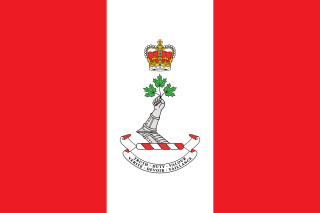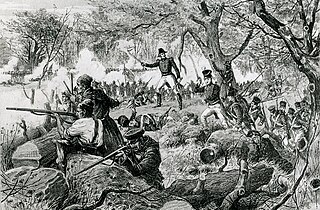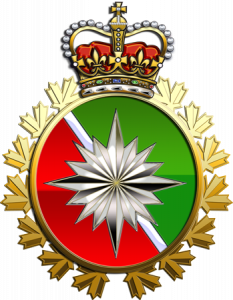
Kingston is a city in Ontario, Canada, on the northeastern end of Lake Ontario. It is at the beginning of the St. Lawrence River and at the mouth of the Cataraqui River, the south end of the Rideau Canal. Kingston is near the Thousand Islands, a tourist region to the east, and the Prince Edward County tourist region to the west. Kingston is nicknamed the "Limestone City" because it has many heritage buildings constructed using local limestone.

The Royal Military College of Canada, abbreviated in English as RMC and in French as CMR, is a military academy and, since 1959, a degree-granting university of the Canadian Armed Forces. It was established in 1874 and conducted its first classes on June 1, 1876. Programs are offered at the undergraduate and graduate levels, both on campus as well as through the college's distance learning program via the Division of Continuing Studies.

The Royal Military College Saint-Jean, commonly referred to as RMC Saint-Jean and CMR, is a Canadian military college and university. It is located on the historical site of Fort Saint-Jean, in Saint-Jean-sur-Richelieu, Quebec, 40 km south of Montreal. RMC Saint-Jean is an arm of the Canadian Military College (CMC) system that provides two college-level programs in Social Science and Science, which are closely integrated with the undergraduate programs offered by the Royal Military College of Canada. RMC Saint-Jean was granted independent university status in 2021, and it currently offers a bachelor's degree in International Studies.

A Canadian Forces base or CFB is a military installation of the Canadian Armed Forces. For a facility to qualify as a Canadian Forces base, it must station one or more major units.
The history of the Canadian Army, began when the title first came into official use in November 1940, during the Second World War, and is still used today. Although the official titles, Mobile Command, and later Land Force Command, were used from February 1968 to August 2011, "Canadian Army" continued to be unofficially used to refer to the ground forces of the Canadian Armed Forces, much as it has been from Confederation in 1867 to the present. The term was often even used in official military publications, for example in recruiting literature and the official newspaper of the Canadian Forces, The Maple Leaf. On August 16, 2011, the title, "Canadian Army", was officially restored, once again bringing the official designation in line with common and historical usage.

When the United States and the United Kingdom went to war against each other in 1812, the major land theatres of war were Upper Canada, Michigan Territory, Lower Canada and the Maritime Provinces of Nova Scotia, New Brunswick, Prince Edward Island and Cape Breton . Each of the separate British administrations formed regular and fencible units, and both full-time and part-time militia units, many of which played a major part in the fighting over the two and a half years of the war.

Brigadier Dollard Ménard was a senior officer in the Canadian Army. As a lieutenant colonel, he was wounded five times during the Dieppe Raid in 1942 while leading Les Fusiliers Mont-Royal. His story inspired a famous Canadian World War II poster Ce qu’il faut pour vaincre. He was later made a Companion of the Distinguished Service Order. Since all of the other commanding officers were either killed or captured, he was the only commanding officer who had landed at Dieppe to return to Britain after the raid.

The Communications and Electronics Branch is a personnel branch of the Canadian Armed Forces (CAF). The army component of the branch is designated the Royal Canadian Corps of Signals.

The Intelligence Branch is a personnel branch of the Canadian Forces (CF) that is concerned with providing relevant and correct information to enable commanders to make decisions.

The Kingston Royal Naval Dockyard was a Royal Navy Dockyard from 1788 to 1853 in Kingston, Ontario, Canada, at the site of the current Royal Military College of Canada.
Edward Chester Plow, was a Canadian soldier and the 22nd Lieutenant Governor of Nova Scotia.

Major Wallace Bruce Matthews Carruthers was an officer of the Canadian Militia and the founder of the Royal Canadian Corps of Signals.
Colonel Count Henry Robert Visart de Bury et de Bocarmé, was a career officer in the British and Canadian army, member of the Belgian nobility, academic, and Director of Canadian Ordnance Services, France.

Major General William Henry Pferinger Elkins, was a Canadian soldier. He was a commandant of the RMC.

Major-General Charles Francis Constantine was a Canadian General and commandant of the Royal Military College of Canada from 1925 to 1930.
Lieutenant-General Sir George Norton Cory, KBE, CB, DSO was an American-born Canadian soldier who served with the British Army in India, South Africa and Canada and during the Boer War, World War I and World War II.
Point Frederick is a 41-hectare (101-acre) peninsula in Kingston, Ontario, Canada. The peninsula is located at the south end of the Rideau Canal where Lake Ontario empties into the St. Lawrence River. Point Frederick is bounded by the Cataraqui River to the west, the St. Lawrence River to the south, and Navy Bay to the east. The peninsula is occupied by the Royal Military College of Canada (RMC). Several of the buildings located on Point Frederick and the site of the old naval dockyard are national historic sites. Fort Frederick, at the south end of the peninsula, is a feature of the Kingston Fortifications National Historic Site of Canada.

Canadian military bands are a group of personnel in the Canadian Armed Forces (CAF) that performs musical duties for military functions. Military bands form a part of the Music Branch of the CAF, composed of six full-time professional Regular Force bands, 15 Regular Force voluntary bands, and 53 part-time reserve force bands. Bands of the Music Branch are often badged with the unit or Canadian Forces base insignia that they support.
The following is a hierarchical outline for the Canadian Armed Forces at the end of the Cold War. It is intended to convey the connections and relationships between units and formations.